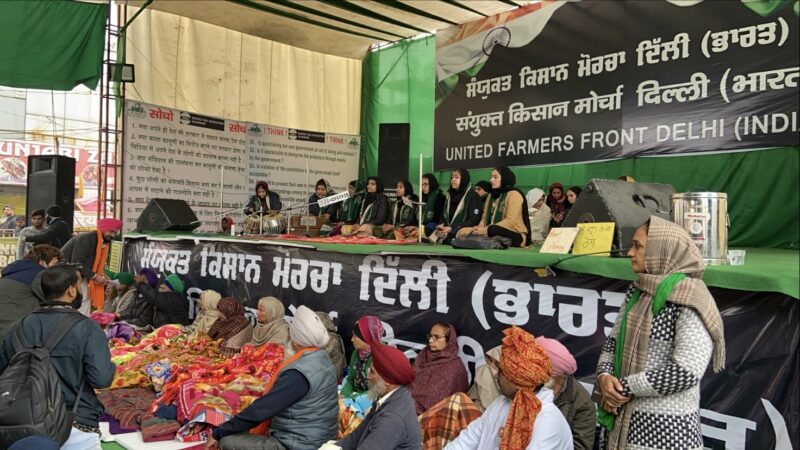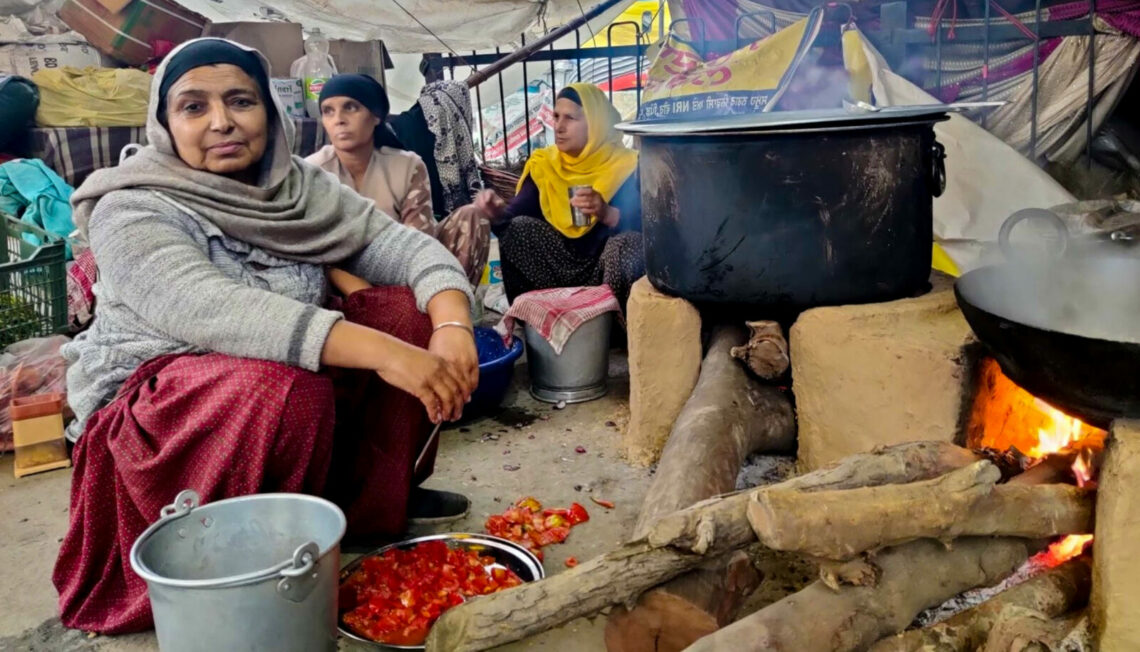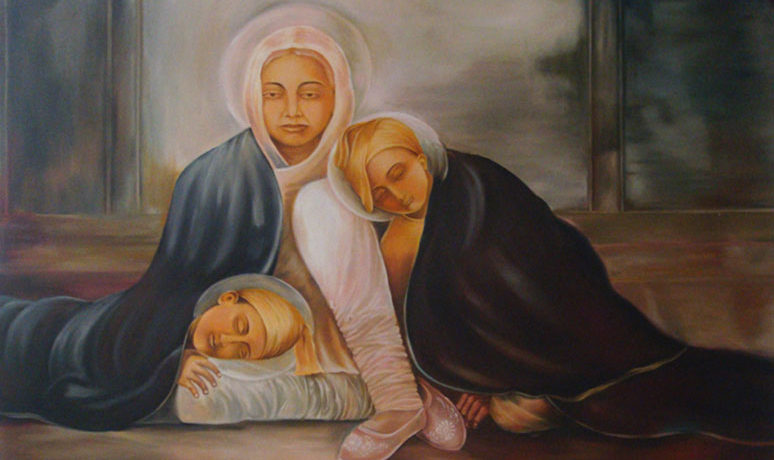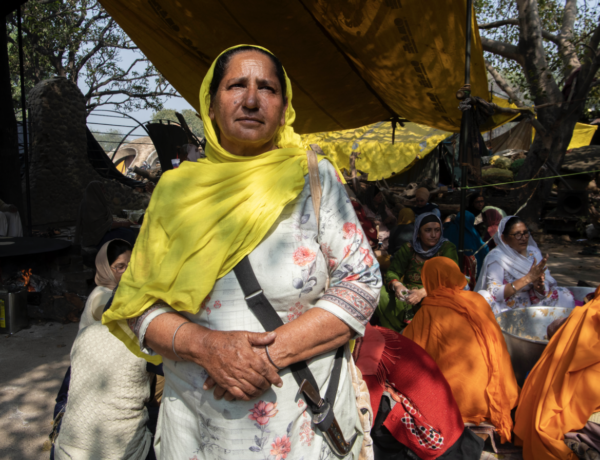Sirjan Kaur lives in Delhi and is currently volunteering at the Singhu Border of Delhi to support the Farmers Protest. These are her thoughts and observations.
Echos of a Rejuvenated Punjab
by Sirjan Kaur
Farm Laws Ignited the Protests
The later half of 2020 witnessed something that can be termed no less than a revolution, one that, I believe, will come with sustained and long term effects in how we know Punjab as existing today. The Farmers’ Protests or what is better referred to as the ‘Kisan Morcha’ marked its beginning in the months of June-July, following the Narendra Modi led Indian Government’s decision to pass three farm laws. All of this was done during the COVID lockdown and further, without due consultation and deliberation with all stakeholders. The passage of the three farm laws lead to the now famous Farmers’ Protest – aa watershed moment in history.
As I write this piece, the protests by the farmers on the borders of Delhi have entered its 55th day and those in Punjab have been protesting for 118 days now. What the farmers did, can be termed as a literal ‘takeover’ of the borders of Delhi. What were previously highways, are now homes for lakhs (100,000s) of people who have been camping out in the chilly Delhi winter. The borders surrounding the capital have been ordained with numerous langars. As the farmers continue unmoving with their morcha, there have been ten rounds of talks between the Central Government and farm union leaders- all of which have failed to achieve a resolution.
I Decided to Volunteer at the Singhu Border
As lakhs of farmers turned the freezing borders of the national capital into their homes, only a few observers could remain indifferent to their situation. As someone who resided in the capital of Delhi, I knew that I had to visit the borders at least once. It started with a few visits of walking long stretches full of tractors and trolleys, and talking to the farmers – old and young alike. It turned into regular volunteering when I came across a story on Instagram asking for people to volunteer at the medical/distribution camp set by the organisation, Initiators of Change. As I pen down this article, it has been 35 days since I first started to volunteer at the camp at Singhu Border- which has now come to feel like home. Even amidst the cold winter, there is warmth in the air, filled with affection, a community feeling and a sense of togetherness.
But all of this is not to suggest that living on the highways is easy. After all, it is a vast stretch of open land, away from the comforts of homes. There is a cold wind that the farmers have to endure, there are long distances they have to travel, there is the chilly fog and nightly mist that they have to navigate through. Having spent a few nights at the border, I feel at a loss of words to describe the hardships the protestors are battling; I can only respond with prayers in my heart, prayers for strength and a resolution.
A Day In the Life of a Protestor
The day starts fairly early for most at the borders- even living in such circumstances couldn’t break the strong resolve of the farmers, who undoubtedly, are accustomed to a life of hard work. As the ambrosial hours of the Amrit Vela dawn, sounds of Nitnem being recited begin to reach the ears from different corners. While it is still dawn, many people, especially the elderly,begin to prepare for their day. Most will take baths with icy cold water – all of this in the month of Poh- the time when winter is the harshest in North India.
Women are the Backbone of the Protests
Among the plethora of elements making the Kisan Morcha historical, the most prominent of all has been the heavy female participation. Women have been the backbone of the protests, to say the least – by coming out in support of the protests and registering their dissent against the three farm laws, they have strengthened the protests further, have broken the shatters of age old stereotypes of the “meke woman,” and given way to reforming and mending our ways as a society.
The Bathroom Question
The day in the life of a female protestor on an average begins usually during the early hours of the dawn. In the initial days of protests, sanitation was a major issue, especially for the females- but subsequently, due to phenomenal efforts by different organisations, such provisions have been taken care of. One for instance, is the wash/bathroom set by Khalsa Aid. Other organisations have also installed portable bathrooms specifically for women. However, with new groups of people pouring in everyday, sanitation facilities for women still remains somewhat a challenge- it’s either long lines that one has to stand in or long distances that one has to cover.
For most, the morning begins with engaging in langar seva – from making parshaadas to chopping vegetables, one witnesses people always eager to serve. While many engage in seva, other groups of women move towards the stage as they recite the paath of Sukhmani Sahib, Salok Mahalla 9. Throughout the day, huge groups of women alternate between eva and listening to speeches at the main stage for hours. The stage witnesses the presence of women speakers equally and has also served as a great platform for young female protestors as well to voice out their opinions.
Women Farmers’ Day
As I write this, it was only yesterday [January 18] that the farmers celebrated the ‘Mahila Kisan Divas’ or Women Farmers’ Day- with women taking over and handling all the responsibilities during the day- from young, bold girls at the security posts, to solely female speakers on the stage to all-women Kirtani jatha.

A Reconnection to Our Roots
While there is a collective fight against the three farm laws, we are simultaneously battling our stereotypes, our attitudes, and the societal evils that had previously inflicted our community living. And that is precisely why this morcha is being referred to as nothing less than a Revolution. We have gained what we had lost in the past- our community feeling has strengthened, there is a reconnect with our roots, it has seen a revival of the energy in the people of the land of Punjab.
As Ananya Vajpeyi states in her book, ‘The Righteous Republic’, every civilisation or community goes through a period of an ‘epistemological crisis’, which if it overcomes, leads to important and sustained changes. And this morcha, I believe, is Punjab’s overcoming from its epistemological crisis- it’s crucial period of rejuvenation. My heart is filled with delight when I spot people reading while soaking in the winter sun or in a quiet corner inside their trolleys. While a few others will be spotted penning down their thoughts in the form of prose and poetry- there is a renaissance not only in terms of the unity that we are witnessing but also in terms of a greater acknowledgment of the importance of staying informed, reading, composing, discussing, and leading.
One of the most inspirational stories in the morcha has come from two groups: 1) young female protestors who are endowed with the responsibility of managing the affairs of the stage and 2) the strong resilience of the elderly women protestors, who relentlessly continue with langar seva. I was fortunate enough to witness such stories of courage and leadership.
Amandeep Kaur Khiva – Youth for Swaraj Student Body
One such young powerhouse is Amandeep Kaur Khiva, a member of the Youth for Swaraj student body- who has been a part of the morcha since the very beginning. “It’s about Punjab, and its very existence. One cannot imagine Punjab without agriculture. And when there is a threat to our existence, resistance becomes our duty,” answered Amandeep when I asked her about her motivation behind being a part of the morcha. She states that the laws will lead to a complete dismantle of the agricultural system as we know today. While previous existence of provisions like Minimum Support Price (MSP) ensured some amount of protection to the farmers, the new farm laws will leave farmers at the mercy of the corporates- who will undoubtedly exploit them.
Regarding receiving support from the Sikh diaspora, Amandeep was delighted to have received support from Punjabis residing all over the world. However, she also hopes to see more on-ground participation from locals residing in cities. She believes this will strengthen the movement further.
When I asked Amandeep on the role of women in the protests she said, “There can be no doubts regarding the close linkage of women and agriculture. It is well known that the agricultural force is composed of 50% females, who handle the household work as well. If mothers can give birth to warriors, it is the same mothers who are capable of giving a tough fight themselves.”
Sukhvinder Kaur- ‘Bebe di Rasoi’
I also got the opportunity to talk to Sukhvinder Kaur Ji, who is known for her ‘Bebe de Rasoi’, which she operates along with a few other elderly women protestors. Set in the spaces between two trolleys, the little corner of Bebe’s free kitchen serves delicious meals throughout the day. The meals are as imbued with love as much as they are with desi ghee! I was lucky enough to chat with Sukhvinder Kaur Ji, while she was free from her seva duties. Sukhvinder Kaur Ji is a resident of village Pratapura, Jalandhar district. She too has been present at the Singhu border since the very first day.
“We are here to serve, to take care of food and other essential needs, so that our children don’t have to worry about these arrangements and can freely take care of things at the forefront,” she said. She expressed her delight over the support received from the diaspora and asserted their continued resolve to fight against the farm laws, while being in a state of Chardi Kala.
Bebe Di Rasoi
My Requests of You
As the farmers continue to stage protests demonstrations at the borders of Delhi for almost 60 days now- there is a greater need for everyone, whether those protesting on the ground or those extending their support to the morcha from different places of the world- to remain in high spirits.
To those who are unable to join us physically: To those extending their support from all over the world, and to those who are not able to join us physically, it is important to keep up the conversation around the farmers’ protests, the three bills, and the years of resistance.
To those who are local: It is important for those in the periphery to ensure their presence at the borders- after all, strength does lie in numbers and we are at a stage where every individual’s support is important.
To the Sikhs of the diaspora: You have an integral role in the movement- to keep the awareness of the protests alive. A major contribution to the protests has been by different organisations, who have been working relentlessly to ensure the provision of essential items and shelter facilities for the protesting farmers. Those looking to help can contribute towards such organisations; it is only through collective strength, unity and strong resolve that we are going to ensure a successful morcha. It is important to inform yourselves with credible resources or if possible, from those present on the ground. The media will continue to demean the protests, the onus is upon you to arm yourselves with the right knowledge.
The Kisan Morcha, has given a platform for us as a community to acknowledge, initiate and bring in greater changes that previously inflicted our community living. It has given space to the reforms that we otherwise yearned for. Those who took Punjab’s youth to have been ruined by addiction- should pay a visit to the border and see for themselves, the way the youth have been handling different sevas- from langar preparations to washing clothes to cleaning drives. The youth has undoubtedly been the supporters of the morcha.
One of the greatest understandings as a result of the protests has been understanding the value of creating independence. The protests have been a perfect depiction of what self-sufficiency looks like. The protests have led to many important realizations like: having a common platform for voicing out the farmers’ issues, strengthening our community living, choosing our leaders wisely, and valuing the people as the real guardians of the democratic spirit.
This is history in the making. This is what will be read about in future. This is something which will hopefully lead to sustained changes in our lives. Everyone is hopeful for a positive result and a resolution. Protests like this will continue to keep the spirit of democracy alive and will continue to prove that the people, when united, shall achieve great heights.





3 Comments
Anonymous
01/21/2021 at 12:17 amYou summarised everything very well and while reading this article I felt I relied my days spent at protest. Great work

Thanks for such lovely and powerful article.
Harjinder Singh
01/23/2021 at 7:43 amVery well articulated article. Makes you realize the pain of farmers. The writer literally takes you inside the heart of agitation and makes sure you stand alongside them for their just cause. Sirjan proud of you and your writing skills. Let the ink never dry down. God bless.
Harjinder Singh
01/23/2021 at 7:44 amVery well articulated article. Makes you realize the pain of farmers. The writer literally takes you inside the heart of agitation and makes sure you stand alongside them for their just cause. Sirjan proud of you and your writing skills. Let the ink never dry down. God bless.